Monday, May 30, 2011
Sunday, May 29, 2011
Why Isn't Chiyori Famous? or, a Grainy Endoscopy of the Japanese Music Industry
I have plenty to say here, but let's let her speak for herself first, in this video from a performance last night at a small club called Bed in Ikebukuro (Western Tokyo):
So, now you'll have at least some small sense of where I'm coming from. This is a woman with gifts in the realm of an Amy Winehouse or Adele (admittedly, this video doesn't quite do those justice), but with a fierce and unique, subtle strangeness that she seems barely aware or in control of (a fact this particular song does highlight). The question is, why is she playing a tiny club like Bed, after putting out a full-length album on a relatively high-profile indie, and putting in years worth of work building a series of events and nights (including this monthly event, Zettai-Mu, itself)? As she said herself when I walked in last night, Bed is "a pretty ghetto club," though in Tokyo that means more 'marginal and cheap' than 'sketchy and dangerous' (You can read her blog here (Japanese), and hear a few more polished recordings here).
In fact, I had a far better time there last night than I did on Friday at Air, which had a vastly superior soundsystem, some great DJs, and all the personality and atmosphere of a Soviet pharmacy. Air is one of what I would call Tokyo's "listening clubs," places including Daikanyama Unit, WWW in Shibuya, and Liquidroom. They have the most mind-bogglingly incredible sound systems (I'm willing to bet) of any club their size on the planet. And they're all beautiful. But they cater to an aggressively upscale trendy market (editors note: decidedly not a 'hipster' market, but young professionals). They most often feel like a collection of strangers, though there are exceptions (for instance, when Liquidroom hosts smaller events in its upstairs lounge).
On the other hand, there are smaller places, quite literally on the outskirts, like Heavy Sick Zero in Nakano, Bed in Ikebukuro, or Family, which is able to exist in Shibuya only because it's literally the size of my apartment. These clubs host smaller, sometimes stranger, always more amateurish shows, for crowds that tend to be more intimate. They're also usually cheaper (entrance to Bed on Saturday was 1/2 to 1/3 the charge for Air on Friday, even though Air was basically just a DJ night and Bed had three bands).
So, now you'll have at least some small sense of where I'm coming from. This is a woman with gifts in the realm of an Amy Winehouse or Adele (admittedly, this video doesn't quite do those justice), but with a fierce and unique, subtle strangeness that she seems barely aware or in control of (a fact this particular song does highlight). The question is, why is she playing a tiny club like Bed, after putting out a full-length album on a relatively high-profile indie, and putting in years worth of work building a series of events and nights (including this monthly event, Zettai-Mu, itself)? As she said herself when I walked in last night, Bed is "a pretty ghetto club," though in Tokyo that means more 'marginal and cheap' than 'sketchy and dangerous' (You can read her blog here (Japanese), and hear a few more polished recordings here).
In fact, I had a far better time there last night than I did on Friday at Air, which had a vastly superior soundsystem, some great DJs, and all the personality and atmosphere of a Soviet pharmacy. Air is one of what I would call Tokyo's "listening clubs," places including Daikanyama Unit, WWW in Shibuya, and Liquidroom. They have the most mind-bogglingly incredible sound systems (I'm willing to bet) of any club their size on the planet. And they're all beautiful. But they cater to an aggressively upscale trendy market (editors note: decidedly not a 'hipster' market, but young professionals). They most often feel like a collection of strangers, though there are exceptions (for instance, when Liquidroom hosts smaller events in its upstairs lounge).
On the other hand, there are smaller places, quite literally on the outskirts, like Heavy Sick Zero in Nakano, Bed in Ikebukuro, or Family, which is able to exist in Shibuya only because it's literally the size of my apartment. These clubs host smaller, sometimes stranger, always more amateurish shows, for crowds that tend to be more intimate. They're also usually cheaper (entrance to Bed on Saturday was 1/2 to 1/3 the charge for Air on Friday, even though Air was basically just a DJ night and Bed had three bands).
Friday, May 27, 2011
The Second Lost Generation - The Story of One Wandering Japanese Engineer
At first it might not seem that cataclysmic that only 90.1 percent of Japanese college grads had jobs lined up on graduation. But the current slump is likely to create a "lost generation" in which large numbers of probably high achievers are completely or largely locked out of the conventional job market, and forced into part-time, temporary, or international work. That's because of a hiring system that only gives seekers one shot - in the period just after they graduate. Those who either want to take some time off, or who slip through the hiring cracks despite a sincere effort, are out of luck. I spent about eight months after my (alread unconventionally late) graduation living on a friends' couch, substitute teaching, then hitchhiking across the U.S. and travelling in Mexico. If I had been Japanese, I'd have been screwed.
I had a brief conversation last night with a guy who has actually had to leave Japan twice for economic reasons. He was part of a previous 'lost generation' of the mid-1990s, and had ended up living and working in New Jersey for several years as a young man, including being in the National Guard, which he told me was a possibility for permanent residents - news to me. This is of course pretty adventurous, and he seemed like he'd banked some pretty amazing experiences, but what he wasn't doing during the most dynamic phase of his life was contributing to Japanese economy and society.
He did eventually get back to Japan and, with the experience accrued (in engineering) in America, got a job with the Japanese arm of a European company. And then came the Lehmann shock, and the Tokyo office got folded and combined with the Shanghai branch. So he was back on his ass, and subsequently couldn't find work for a year. Now he's doing some (frankly illegal) entrepreneuring, running a company that scans books from Amazon Japan for use on e-readers, since there is as yet no e-book market there. He had imported a Kindle from the U.S. (which I've seen before but this time particularly struck me as impressive) and clearly had a lot to offer in terms of insight and innovation to Japanese society. Unfortunately (as confirmed by the small anarchist bar where I ran into him) he's now been almost totally relegated to the fringes, where it's unlikely he'll have an easy path to making those contributions.
In the economic tumult following Japan's largest natural disaster, there will be more like my new friend, having to improvise to survive outside of the mainstream of Japanese business culture. The question is whether there will be any more second chances for them, or any new effort by the nation to make the most of its infamously dwindling workforce.
I had a brief conversation last night with a guy who has actually had to leave Japan twice for economic reasons. He was part of a previous 'lost generation' of the mid-1990s, and had ended up living and working in New Jersey for several years as a young man, including being in the National Guard, which he told me was a possibility for permanent residents - news to me. This is of course pretty adventurous, and he seemed like he'd banked some pretty amazing experiences, but what he wasn't doing during the most dynamic phase of his life was contributing to Japanese economy and society.
He did eventually get back to Japan and, with the experience accrued (in engineering) in America, got a job with the Japanese arm of a European company. And then came the Lehmann shock, and the Tokyo office got folded and combined with the Shanghai branch. So he was back on his ass, and subsequently couldn't find work for a year. Now he's doing some (frankly illegal) entrepreneuring, running a company that scans books from Amazon Japan for use on e-readers, since there is as yet no e-book market there. He had imported a Kindle from the U.S. (which I've seen before but this time particularly struck me as impressive) and clearly had a lot to offer in terms of insight and innovation to Japanese society. Unfortunately (as confirmed by the small anarchist bar where I ran into him) he's now been almost totally relegated to the fringes, where it's unlikely he'll have an easy path to making those contributions.
In the economic tumult following Japan's largest natural disaster, there will be more like my new friend, having to improvise to survive outside of the mainstream of Japanese business culture. The question is whether there will be any more second chances for them, or any new effort by the nation to make the most of its infamously dwindling workforce.
Tuesday, May 24, 2011
Photo Roundup: Nikko
Late last week I took a quick trip to Nikko, famous for its monkeys, hot springs, and an ornate shrine to the Tokugawa Shogunate.
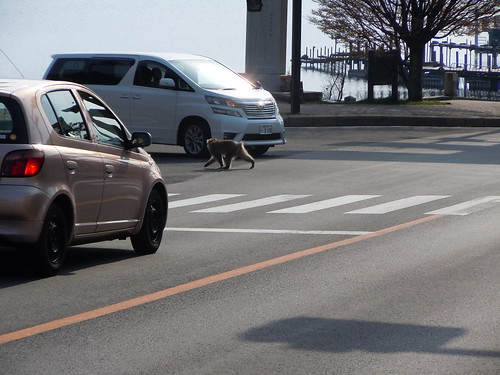
The monkey thing is real. Unfortunately it seems like contact with humans has not been great for their dispositions - just moments after I took this photo, these monkeys were aggressively harassing and chasing a woman in her sixties. Hard to imagine anything more terrifying.

The monkey thing is real. Unfortunately it seems like contact with humans has not been great for their dispositions - just moments after I took this photo, these monkeys were aggressively harassing and chasing a woman in her sixties. Hard to imagine anything more terrifying.
Monday, May 23, 2011
Regarding Workers
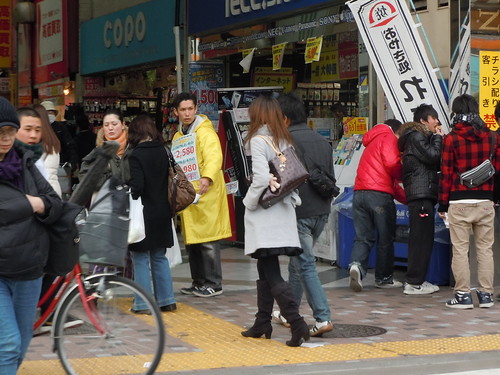
I took the above photo a couple of days after the 3.11 earthquake, mainly to illustrate the amazing speed with which Tokyo returned to everyday normality. The guy in the middle is just one subtype of an eternal Tokyo presence - the sidewalk promoter. He's giving out flyers (and probably tissue packages) to promote a contact lens shop, but you'll also see people doing much the same work in service of Italian restaurants, Karaoke boxes, manga kissaten, Korean barbecues, and hostess clubs (including the vile subspecies who harass passing young women to try and lure them into the sex industry).
I've lately been thinking about how little I understand the human element of a job like this. It's just one of a variety of undeniably crappy jobs you see people doing every day in a city like Tokyo, from fast-food server to Donki clerk to construction-site traffic-director. The last time I worked a job of this sort was about a year ago, when I did short stints as a parking-lot attendant and line-cook as part of my confused attempts to deal with unexpected funding shortfalls in my last year of grad school. Both were part-time jobs, and the line cook job was actually a hell of a lot of fun, but I ended up quitting both jobs with no notice in moments of frustration and/or overwork.
I had that option, because I knew I was on my way to other things, but I was nonetheless able to hold onto some (facile, superficial) sense of solidarity with "workers," thanks to my cushioned, provisional version of poverty, and the genuinely merciless grind of grad school, in some ways undeniably more demanding and even exploitative than this sort of service job.
Now, though, I'm realizing how much that illusion of lived solidarity was insulating me from a real consideration of the challenges posed by living in a mercilessly stratified society. Job-wise, I'm now living a ridiculous fantasy, which if not quite financially secure does happen to include total freedom. I'm suddenly not sure how to feel about the legions of workers through whom I float, to whose daily struggle I find it more and more difficult to truly relate.
Labels:
academia,
activism,
anarchism,
capitalism,
economics,
ethnography,
Freeter,
identity,
ideology,
japan,
music life,
politics,
the city,
tokyo
Food Fetish: Nikko, Yuba, and Localism in Japanese Junk Food
Towards the end of last week I spent a couple of days in Nikko, a nice relaxing solo trip. I made a point of eating every variety of the local specialty, yuba, that I could get my hands on. Yuba is made from the curd skimmed during the process of making soy milk, and is particularly associated with Nikko because it was a source of protein for the vegetarian yamabushi (mountain monks) that populated its famous shrines (and, in smaller numbers, still do).
It's more appetizing than it sounds, making this a tasty chance to trace an archetype of Japanese food localism. In short, this localism is mostly a marketing strategy aimed at travelers that provides nominal variation while still keeping things comfortably familiar. To wit:
It's more appetizing than it sounds, making this a tasty chance to trace an archetype of Japanese food localism. In short, this localism is mostly a marketing strategy aimed at travelers that provides nominal variation while still keeping things comfortably familiar. To wit:
A typical bowl of soba, you say? Not at all - it's yuba soba, transformed by those yellowish rolls. This was the tastiest of the variations I tried, partly because it was eaten in a small restaurant at the end of a five-hour hike.
Sunday, May 15, 2011
Interview: Strotter Inst.
At the beginning of the month, I was lucky enough to get my socks blown off by Strotter Inst, a.k.a. Christoph Hess, a Nordic mad scientist who has modified a series of turntables into some retrgrade form of drum machine, and feeds them fragments of destitute twelve-inch corpses to produce hypnotic industrial polyphony. I was so enthused I took the time to send him a few questions, and he was generous enough to answer them. (All photos courtesy of Strotter's website).
Q: This was your first time to Japan, what did you think about it?
A: I just stayed for one week, but I have had a great time impressed by the whole town, meeting all these nice and friendly people. And it was big fun to play again with SXQ from Tokyo, after we met on a Russian tour in
2008.
Q: Are the audiences here much different than what you’re used to?
A: As I am lucky to play in very different kind of venues and scenes, I'm used to very different audiences. But I had hardly seen such an enthusiastic one like in Tokyo. Another point is the volume the concerts were played and no one was using earplugs...
FFTA
As a way of (deluding myself into thinking that I'm) practicing Japanese, I picked up a couple of Japanese-language video games. One I just started (Referenced above) begins with a forty-minute (at least) narrative sequence. According to wikipedia, the designers of this game were not drug into the streets and beaten to death upon its release. The only possible conclusion is that Wikipedia is, just as has been said for so long, an unreliable resource.
Saturday, May 14, 2011
Photo Roundup: May 2011
A few highlights from the past few weeks:
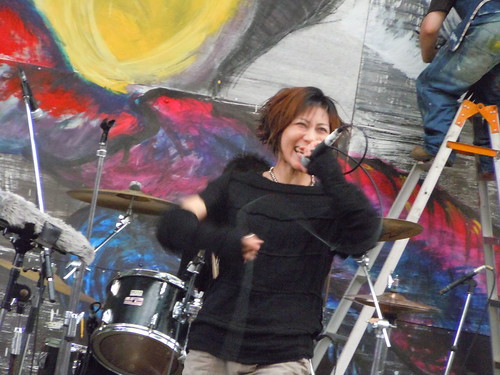
Melt Banana today, 5/14
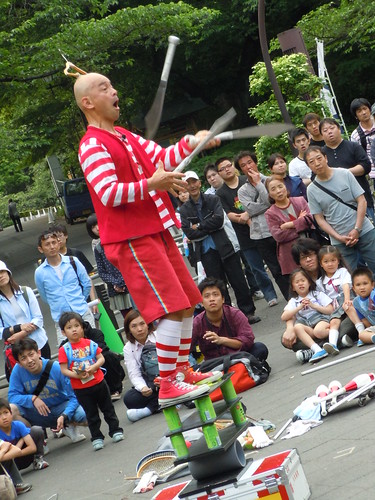
A really stunning juggler in Ueno park

A famous mural by Okamoto Taro in Shibuya Station. Apparently the central figure is the inspiration for the apocalyptic robots of the Evangelion cartoons.
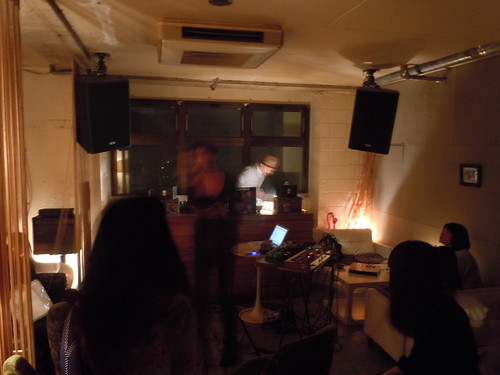
Slovenia's most popular rapper, at a small bar in Koenji called One.

Noise and generative video at Soup, Koenji.

Melt Banana today, 5/14

A really stunning juggler in Ueno park

A famous mural by Okamoto Taro in Shibuya Station. Apparently the central figure is the inspiration for the apocalyptic robots of the Evangelion cartoons.

Slovenia's most popular rapper, at a small bar in Koenji called One.

Noise and generative video at Soup, Koenji.
Labels:
japan,
music,
music life,
noise,
photos,
underground
Thursday, May 12, 2011
BRK(L)N Connections: Hip Hop and Noise and Music and Technology
Tomorrow from about 7:30 at the fantastic club Superdeluxe, the leftfield rapper Killer Bong teams up with Japanoise stalwart Hair Stylistics – Masaya Nakahara, formerly known as Violent Onsen Geisha – to do . . . something. I’m not sure what. But apparently K-Bong does it pretty frequently, and has performed in the past with a lot of other noise artists. There’s a three-way collaboration coming up in July between Bong, DJ Baku, and Merzbow (more info as it comes my way).
The connection between hip hop and noise is also being mined across the Pacific, where the single hottest rap crew of the moment, OFWGKTA, made a big portion of its bones in affiliation with the underground psych blogosphere, sites like Gorilla Vs. Bear that mainly traffic in spacey drone-pop and the softer-edged, lo-fi, Occidental version of ‘noise.’ Another current example is the group Shabbazz Palaces, who make rap that’s stretchy and dubbed-out enough to sit comfortably next to neo-hippies like Peaking Lights and Grouper.
But this is deeper than any of-the-moment trend. Hip hop and experimental music have been worshipping at each other’s altar since the early eighties, a source traceable backwards not just in the self-conscious path through DALEK, Cannibal Ox, cLOUDDEAD, Kid 606, Dr. Octagon, Maquinquaye, and Bill Laswell* (*figuring out why exactly he’s terrible deserves a separate post), but all over the pop charts and the hearts of the dismissed “old school.”
Here’s Rammellzee’s epic “Exterior Street” (1985)
Yin-Yang Twins "Salt Shaker" (2003), which still basically sounds like Can. I could also have linked J-Kwon’s “Tipsy” (2007), the stupidest extremely weird song I can think of.
And Lil B’s “Motivation” (2011), with Clams Casino mining psych to give us one of the greatest tracks of all time.
Why do these aliens keep surfacing in a genre that we tend to believe we’ve tamed? More than some weird micro-trend that’s kept alive by willful eccentrics, this is the inevitable return of the repressed – hip hop may have gone pop, but at its root are the same forces that have been explored more self-consciously by “art music” in both its conservatory and basement forms. Hip hop is a product of technology as much as of music – its lineage stretches to the turntable and sampler no less than to James Brown and Lee Perry (and there’s no Lee Perry without the reel-to-reel, a.k.a. the turntable before the turntable).
While Morton Subotnick, Robert Moog, and various inventors and entrepreneurs were pushing the boundaries of audio technology, the beatmatchers and backscrathers of the Bronx were encountering and harnessing the potentials that had already been released into the world – new forms of recording, playback, amplification, and (later) sampling and synthesis. But they weren’t just going with the flow – they were breaking things, overloading them, detourning them: the “scratch” is a more radical analog to John Cage’s prepared piano (more radical because it entirely reconceived the purpose of the turntable, though this was itself a repeat of another of Cage’s accomplishments). Add to that the fact that while rapping did derive partly from Jamaican toasting, which derived, along with reggae, from American soul and R&B (and thus has at least a link with rock and roll), another major source was the patter of DJs on southern black radio stations – here again another cultural innovation driven powerfully by technology (for more on this, including some amazing transcriptions of proto-rap from the 1950s, see Roni Sarig’s Third Coast).
There's something here about the relationship between the avante-garde and the everyday. Did experimentalists like Luc Ferrari somehow prepare the way for hip hop? There are, of course, a few direct connections, particularly how much the Bronx loved Kraftwerk. And never underestimate the determination of a music nerd to self-educate, even if they're mired in abject poverty. But I've never read any indication that people like Herc were consciously aware of those developments. The more plausible, and coincidentally much more interesting hypothesis would be that hip hop and noise are parallel outgrowths of our media and technological environment, though certainly inflected by cultural differences. The consequence is that whenever hip hop gets truly self-reflective, it has a strong tendency to turn into noise and go underground. Just about as often, the pop impulse in hip hop forms a channel for the welling up of strange machine artifacts into the mainstream of American life.
The connection between hip hop and noise is also being mined across the Pacific, where the single hottest rap crew of the moment, OFWGKTA, made a big portion of its bones in affiliation with the underground psych blogosphere, sites like Gorilla Vs. Bear that mainly traffic in spacey drone-pop and the softer-edged, lo-fi, Occidental version of ‘noise.’ Another current example is the group Shabbazz Palaces, who make rap that’s stretchy and dubbed-out enough to sit comfortably next to neo-hippies like Peaking Lights and Grouper.
But this is deeper than any of-the-moment trend. Hip hop and experimental music have been worshipping at each other’s altar since the early eighties, a source traceable backwards not just in the self-conscious path through DALEK, Cannibal Ox, cLOUDDEAD, Kid 606, Dr. Octagon, Maquinquaye, and Bill Laswell* (*figuring out why exactly he’s terrible deserves a separate post), but all over the pop charts and the hearts of the dismissed “old school.”
Here’s Rammellzee’s epic “Exterior Street” (1985)
Yin-Yang Twins "Salt Shaker" (2003), which still basically sounds like Can. I could also have linked J-Kwon’s “Tipsy” (2007), the stupidest extremely weird song I can think of.
And Lil B’s “Motivation” (2011), with Clams Casino mining psych to give us one of the greatest tracks of all time.
Why do these aliens keep surfacing in a genre that we tend to believe we’ve tamed? More than some weird micro-trend that’s kept alive by willful eccentrics, this is the inevitable return of the repressed – hip hop may have gone pop, but at its root are the same forces that have been explored more self-consciously by “art music” in both its conservatory and basement forms. Hip hop is a product of technology as much as of music – its lineage stretches to the turntable and sampler no less than to James Brown and Lee Perry (and there’s no Lee Perry without the reel-to-reel, a.k.a. the turntable before the turntable).
While Morton Subotnick, Robert Moog, and various inventors and entrepreneurs were pushing the boundaries of audio technology, the beatmatchers and backscrathers of the Bronx were encountering and harnessing the potentials that had already been released into the world – new forms of recording, playback, amplification, and (later) sampling and synthesis. But they weren’t just going with the flow – they were breaking things, overloading them, detourning them: the “scratch” is a more radical analog to John Cage’s prepared piano (more radical because it entirely reconceived the purpose of the turntable, though this was itself a repeat of another of Cage’s accomplishments). Add to that the fact that while rapping did derive partly from Jamaican toasting, which derived, along with reggae, from American soul and R&B (and thus has at least a link with rock and roll), another major source was the patter of DJs on southern black radio stations – here again another cultural innovation driven powerfully by technology (for more on this, including some amazing transcriptions of proto-rap from the 1950s, see Roni Sarig’s Third Coast).
There's something here about the relationship between the avante-garde and the everyday. Did experimentalists like Luc Ferrari somehow prepare the way for hip hop? There are, of course, a few direct connections, particularly how much the Bronx loved Kraftwerk. And never underestimate the determination of a music nerd to self-educate, even if they're mired in abject poverty. But I've never read any indication that people like Herc were consciously aware of those developments. The more plausible, and coincidentally much more interesting hypothesis would be that hip hop and noise are parallel outgrowths of our media and technological environment, though certainly inflected by cultural differences. The consequence is that whenever hip hop gets truly self-reflective, it has a strong tendency to turn into noise and go underground. Just about as often, the pop impulse in hip hop forms a channel for the welling up of strange machine artifacts into the mainstream of American life.
Sunday, May 8, 2011
5.7 Anti-Nuclear Demo: A Simplistic Message Fuels a Profound Event
I've already waited too long to set down some version of my very intense experience at Saturday's anti-nuclear rally. The numbers coming back from news organizations paint it as a bit of a disappointment - partly due to rain, partly due to a major victory handed to activists by PM Kan just the day before, in the form of the ordered shutdown of a reactor in central Japan. Speaking strictly for myself, I think the core message of the demo - "No Nukes!" - is almost childishly simple, perhaps distracting from the really constructive project of promoting renewable energy, not to mention the more profound and radical possibilities for overhauling industrial capitalism (perish the thought).
All that aside, this was a transformative event. I came to it as someone who has attended a lot of marches put on by the central organizers of this demo, Shirouto no Ran. They frequently have demo/parties on May Day and generally are interested in poverty issues - but always with a slightly confrontational edge, including a profusion of absurdism and rnoisy music, which helped these marches palpably alienate passersby. This one was different.
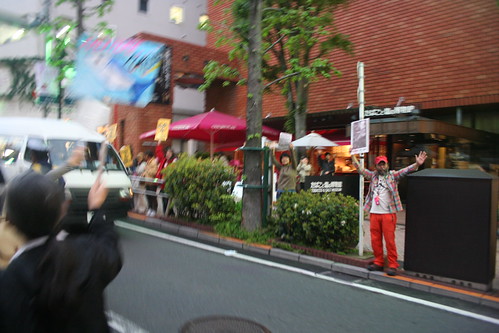
All along the route, there were both people who seem to have broken off from the march (as seen here), and those who just happened to be passing by, saw what was happening, and smiled, waved, or in some cases started cheering along. The energy was amazing.
Another great thing was how wide a spectrum of people was represented, from kids to older folks, and not just fringe or freaky people. Many of these people had never participated in this sort of demonstration before.
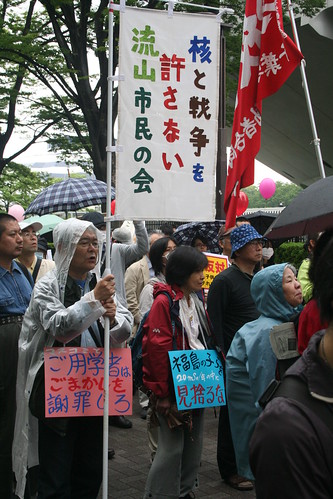
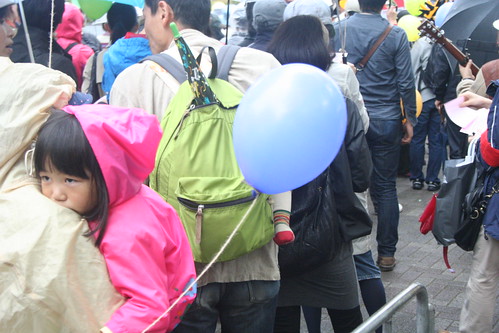
This is a huge contrast with the regular Shirouto no Ran demo, which is made up largely of punk rockers, dadaists, and other weirdos (not that there weren't some of those here).
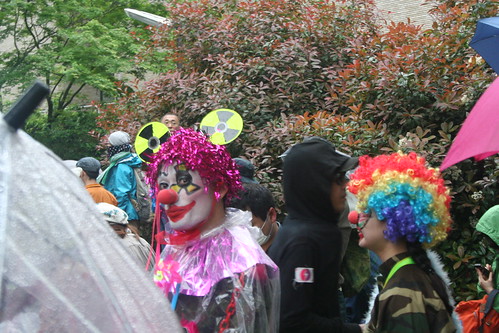
I suddenly found myself with a new appreciation for all those slightly alienated May Day marches, whose effectiveness I've always been pretty skeptical of. They were dress rehearsals for this - an issue powerful enough to draw in people, who just need experienced organizers to give them an outlet for their anxiety and anger.


All that aside, this was a transformative event. I came to it as someone who has attended a lot of marches put on by the central organizers of this demo, Shirouto no Ran. They frequently have demo/parties on May Day and generally are interested in poverty issues - but always with a slightly confrontational edge, including a profusion of absurdism and rnoisy music, which helped these marches palpably alienate passersby. This one was different.

All along the route, there were both people who seem to have broken off from the march (as seen here), and those who just happened to be passing by, saw what was happening, and smiled, waved, or in some cases started cheering along. The energy was amazing.
Another great thing was how wide a spectrum of people was represented, from kids to older folks, and not just fringe or freaky people. Many of these people had never participated in this sort of demonstration before.


This is a huge contrast with the regular Shirouto no Ran demo, which is made up largely of punk rockers, dadaists, and other weirdos (not that there weren't some of those here).

I suddenly found myself with a new appreciation for all those slightly alienated May Day marches, whose effectiveness I've always been pretty skeptical of. They were dress rehearsals for this - an issue powerful enough to draw in people, who just need experienced organizers to give them an outlet for their anxiety and anger.


Tiny Steps
A common sight on the streets of Tokyo is a man, perhaps in his late seventies, shuffling along the sidewalk, taking steps of no more than three or four centimeters at a time, carefully supporting himself first by a bit of wall, then a pole, then a guardrail. They move with an almost unreal slowness as everyone else on the sidewalk streams around them.
Another common sight is women, also in their late seventies or early eighties, bent nearly double by osteoporosis and hanging onto a walker or grocery cart as if to a chariot speeding out of control as they slowly totter down the street.
These are people old enough to have suffered two abuses. Their health can't have been helped by childhoods lived during the postwar years of near-starvation. And their society has changed beneath their feet from one in which social standards still provided some protection for the elderly (if not the more elusive respect that Orientalism imagines) to one seeking to replace familial trust with indequate state support.
Another common sight is women, also in their late seventies or early eighties, bent nearly double by osteoporosis and hanging onto a walker or grocery cart as if to a chariot speeding out of control as they slowly totter down the street.
These are people old enough to have suffered two abuses. Their health can't have been helped by childhoods lived during the postwar years of near-starvation. And their society has changed beneath their feet from one in which social standards still provided some protection for the elderly (if not the more elusive respect that Orientalism imagines) to one seeking to replace familial trust with indequate state support.
Sunday, May 1, 2011
David Schmidtz - Motivation and Tips for Writing
There are dozens of great pieces of advice here. Watch it repeatedly. Or if you're as venal as me, skip straight to part two, where Schmidtz does some stunning math - writing enough can net you hundreds of thousands of dollars a year in additional salary.
Subscribe to:
Posts (Atom)

